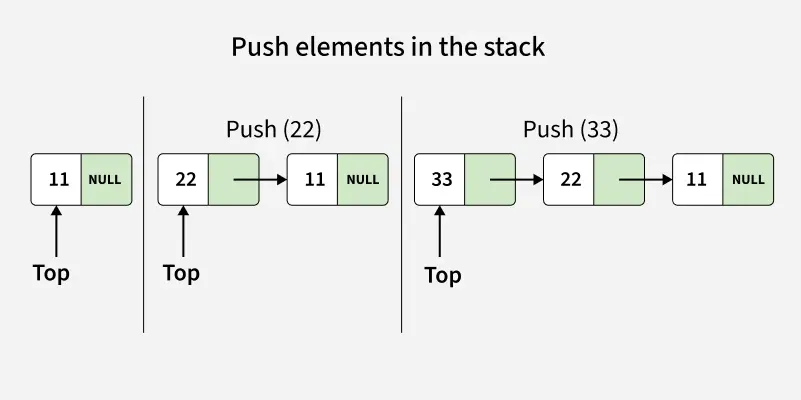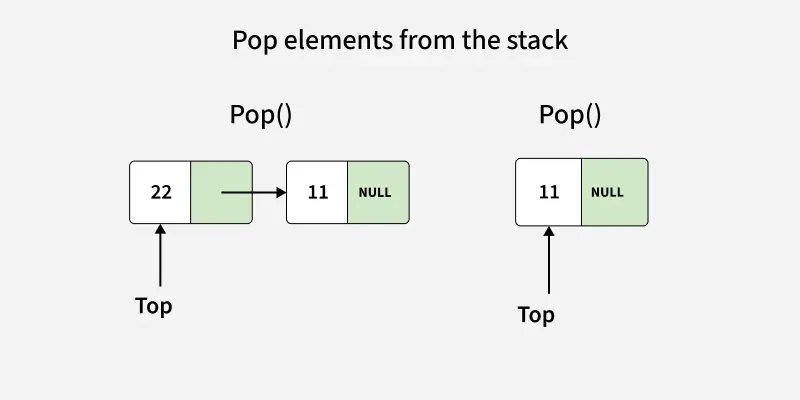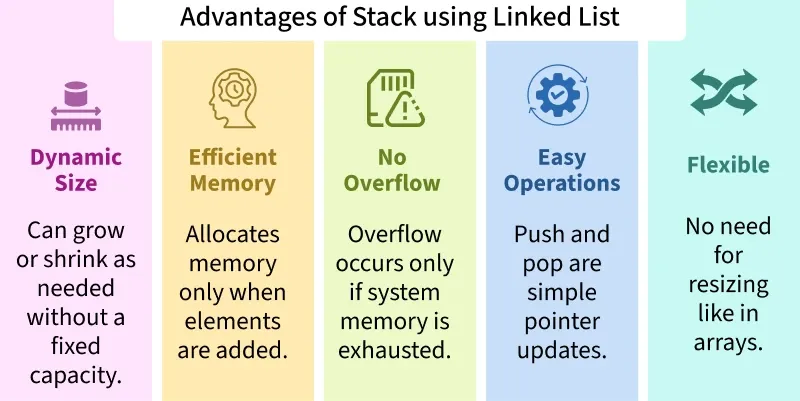Stack - Linked List Implementation
Last Updated : 13 Sep, 2025
A stack is a linear data structure that follows the Last-In-First-Out (LIFO) principle. It can be implemented using a linked list, where each element of the stack is represented as a node. The head of the linked list acts as the top of the stack.
Declaration of Stack using Linked List
A stack can be implemented using a linked list where we maintain:
- A Node structure/class that contains:
data → to store the element.
next → pointer/reference to the next node in the stack. - A pointer/reference top that always points to the current top node of the stack.
Initially, top = null to represent an empty stack.
C++ // Node structure class Node { public: int data; Node* next; Node(int x) { data = x; next = NULL; } }; // Stack class class myStack { // pointer to top node Node* top; public: myStack() { // initially stack is empty top = NULL; } }; /* Node structure */ class Node { public int data; public Node next; public Node(int x) { data = x; next = null; } } /* Stack class */ class MyStack { // pointer to top node private Node top; public MyStack() { // initially stack is empty top = null; } } # Node structure class Node: def __init__(self, x): self.data = x self.next = None # Stack class class myStack: def __init__(self): # initially stack is empty self.top = None
/* Node structure */ public class Node { public int data { get; set; } public Node next { get; set; } public Node(int x) { data = x; next = null; } } /* Stack class */ public class myStack { // pointer to top node private Node top; public myStack() { // initially stack is empty top = null; } } /* Node structure */ class Node { constructor(x) { this.data = x; this.next = null; } } /* Stack class */ class myStack { // pointer to top node top = null; constructor() { // initially stack is empty } } Operations on Stack using Linked List
Push Operation
Adds an item to the stack. Unlike array implementation, there is no fixed capacity in linked list. Overflow occurs only when memory is exhausted.
- A new node is created with the given value.
- The new node’s next pointer is set to the current top.
- The top pointer is updated to point to this new node.

C++ void push(int x) { Node* temp = new Node(x); temp->next = top; top = temp; } void push(int x) { Node temp = new Node(x); temp.next = top; top = temp; } def push(self, x): temp = Node(x) temp.next = self.top self.top = temp
void push(int x) { Node temp = new Node(x); temp.next = top; top = temp; } function push(x) { let temp = new Node(x); temp.next = top; top = temp; } Time Complexity: O(1)
Auxiliary Space: O(1)
Pop Operation
Removes the top item from the stack. If the stack is empty, it is said to be an Underflow condition.
- Before deleting, we check if the stack is empty (top == NULL).
- If the stack is empty, underflow occurs and deletion is not possible.
- Otherwise, we store the current top node in a temporary pointer.
- Move the top pointer to the next node.
- Delete the temporary node to free memory.

C++ int pop() { if (top == NULL) { cout << "Stack Underflow" << endl; return -1; } Node* temp = top; top = top->next; int val = temp->data; delete temp; return val; } public int pop() { if (top == null) { System.out.println("Stack Underflow"); return -1; } Node temp = top; top = top.next; int val = temp.data; temp = null; return val; } def pop(self): if self.top is None: print("Stack Underflow") return -1 temp = self.top self.top = self.top.next val = temp.data del temp return val int pop() { if (top == null) { Console.WriteLine("Stack Underflow"); return -1; } Node temp = top; top = top.next; int val = temp.data; temp = null; return val; } function pop() { if (this.top === null) { console.log('Stack Underflow'); return -1; } let temp = this.top; this.top = this.top.next; let val = temp.data; temp = null; return val; } Time Complexity: O(1)
Auxiliary Space: O(1)
Peek (or Top) Operation
Returns the value of the top item without removing it from the stack.
- If the stack is empty (top == NULL), then no element exists.
- Otherwise, simply return the data of the node pointed by top.
C++ int peek() { if (top == NULL) { cout << "Stack is Empty" << endl; return -1; } return top->data; } int peek() { if (top == null) { System.out.println("Stack is Empty"); return -1; } return top.data; } def peek(self): if self.top is None: print("Stack is Empty") return -1 return self.top.data int peek() { if (top == null) { Console.WriteLine("Stack is Empty"); return -1; } return top.data; } function peek() { if (top === null) { console.log('Stack is Empty'); return -1; } return top.data; } Time Complexity: O(1)
Auxiliary Space: O(1)
isEmpty Operation
Checks whether the stack has no elements.
- If the top pointer is NULL, it means the stack is empty and the function returns true.
- Otherwise, it returns false.
C++ bool isEmpty() { return top == NULL; } boolean isEmpty() { return top == null; } def isEmpty(self): return self.top is None
bool isEmpty() { return top == null; } function isEmpty() { return top === null; } Time Complexity: O(1)
Auxiliary Space: O(1)
Stack Implementation using Linked List
C++ #include <iostream> using namespace std; // Node structure class Node { public: int data; Node* next; Node(int x) { data = x; next = NULL; } }; // Stack implementation using linked list class myStack { Node* top; // To Store current size of stack int count; public: myStack() { // initially stack is empty top = NULL; count = 0; } // push operation void push(int x) { Node* temp = new Node(x); temp->next = top; top = temp; count++; } // pop operation int pop() { if (top == NULL) { cout << "Stack Underflow" << endl; return -1; } Node* temp = top; top = top->next; int val = temp->data; count--; delete temp; return val; } // peek operation int peek() { if (top == NULL) { cout << "Stack is Empty" << endl; return -1; } return top->data; } // check if stack is empty bool isEmpty() { return top == NULL; } // size of stack int size() { return count; } }; int main() { myStack st; // pushing elements st.push(1); st.push(2); st.push(3); st.push(4); // popping one element cout << "Popped: " << st.pop() << endl; // checking top element cout << "Top element: " << st.peek() << endl; // checking if stack is empty cout << "Is stack empty: " << (st.isEmpty() ? "Yes" : "No") << endl; // checking current size cout << "Current size: " << st.size() << endl; return 0; } // Node structure class Node { int data; Node next; Node(int x) { data = x; next = null; } } // Stack implementation using linked list class myStack { Node top; // To Store current size of stack int count; myStack() { // initially stack is empty top = null; count = 0; } // push operation void push(int x) { Node temp = new Node(x); temp.next = top; top = temp; count++; } // pop operation int pop() { if (top == null) { System.out.println("Stack Underflow"); return -1; } Node temp = top; top = top.next; int val = temp.data; count--; return val; } // peek operation int peek() { if (top == null) { System.out.println("Stack is Empty"); return -1; } return top.data; } // check if stack is empty boolean isEmpty() { return top == null; } // size of stack int size() { return count; } public static void main(String[] args) { myStack st = new myStack(); // pushing elements st.push(1); st.push(2); st.push(3); st.push(4); // popping one element System.out.println("Popped: " + st.pop()); // checking top element System.out.println("Top element: " + st.peek()); // checking if stack is empty System.out.println("Is stack empty: " + (st.isEmpty() ? "Yes" : "No")); // checking current size System.out.println("Current size: " + st.size()); } } # Node structure class Node: def __init__(self, x): self.data = x self.next = None # Stack implementation using linked list class myStack: def __init__(self): # initially stack is empty self.top = None self.count = 0 # push operation def push(self, x): temp = Node(x) temp.next = self.top self.top = temp self.count += 1 # pop operation def pop(self): if self.top is None: print("Stack Underflow") return -1 temp = self.top self.top = self.top.next val = temp.data self.count -= 1 return val # peek operation def peek(self): if self.top is None: print("Stack is Empty") return -1 return self.top.data # check if stack is empty def isEmpty(self): return self.top is None # size of stack def size(self): return self.count if __name__ == "__main__": st = myStack() # pushing elements st.push(1) st.push(2) st.push(3) st.push(4) # popping one element print("Popped:", st.pop()) # checking top element print("Top element:", st.peek()) # checking if stack is empty print("Is stack empty:", "Yes" if st.isEmpty() else "No") # checking current size print("Current size:", st.size()) using System; // Node structure class Node { public int data; public Node next; public Node(int x) { data = x; next = null; } } // Stack implementation using linked list class myStack { Node top; // To Store current size of stack int count; public myStack() { // initially stack is empty top = null; count = 0; } // push operation public void push(int x) { Node temp = new Node(x); temp.next = top; top = temp; count++; } // pop operation public int pop() { if (top == null) { Console.WriteLine("Stack Underflow"); return -1; } Node temp = top; top = top.next; int val = temp.data; count--; return val; } // peek operation public int peek() { if (top == null) { Console.WriteLine("Stack is Empty"); return -1; } return top.data; } // check if stack is empty public bool isEmpty() { return top == null; } // size of stack public int size() { return count; } static void Main(string[] args) { myStack st = new myStack(); // pushing elements st.push(1); st.push(2); st.push(3); st.push(4); // popping one element Console.WriteLine("Popped: " + st.pop()); // checking top element Console.WriteLine("Top element: " + st.peek()); // checking if stack is empty Console.WriteLine("Is stack empty: " + (st.isEmpty() ? "Yes" : "No")); // checking current size Console.WriteLine("Current size: " + st.size()); } } // Node structure class Node { constructor(x) { this.data = x; this.next = null; } } // Stack implementation using linked list class myStack { constructor() { // initially stack is empty this.top = null; this.count = 0; } // push operation push(x) { let temp = new Node(x); temp.next = this.top; this.top = temp; this.count++; } // pop operation pop() { if (this.top === null) { console.log("Stack Underflow"); return -1; } let temp = this.top; this.top = this.top.next; let val = temp.data; this.count--; return val; } // peek operation peek() { if (this.top === null) { console.log("Stack is Empty"); return -1; } return this.top.data; } // check if stack is empty isEmpty() { return this.top === null; } // size of stack size() { return this.count; } } // Driver code let st = new myStack(); // pushing elements st.push(1); st.push(2); st.push(3); st.push(4); // popping one element console.log("Popped:", st.pop()); // checking top element console.log("Top element:", st.peek()); // checking if stack is empty console.log("Is stack empty:", st.isEmpty() ? "Yes" : "No"); // checking current size console.log("Current size:", st.size()); OutputPopped: 4 Top element: 3 Is stack empty: No Current size: 3

Explore
DSA Fundamentals
Data Structures
Algorithms
Advanced
Interview Preparation
Practice Problem
My Profile